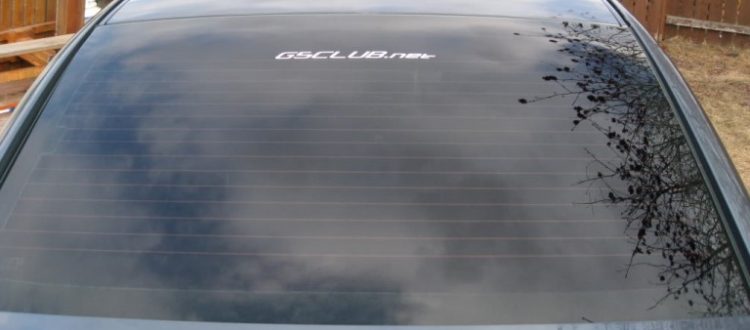Easy removal of reflective stickers from license plates, and the effect of car decals on the rear window line defroster.
Question: How do I remove the reflective tab sticker from my license plate?
I assume you’re talking about the reflective date sticker? Generally speaking, at least for most people I know, we just keep piling this year’s sticker on top of last year’s reflective sticker. Of course, if you are a perfectionist, this might not be an option for you, in which case, we feel sympathy for your wife or husband.
1. Apply some heat.
 As with most stickers, the best way to remove them is to use some heat. A heat gun (at a low setting) or a hair dryer on high heat should provide enough heat to soften the acrylic adhesive so that you can, at the very least, be able to remove the vinyl itself from the decal below it, whether it is last year’s reflective decal date tab or if you’re getting down to the plate itself.
As with most stickers, the best way to remove them is to use some heat. A heat gun (at a low setting) or a hair dryer on high heat should provide enough heat to soften the acrylic adhesive so that you can, at the very least, be able to remove the vinyl itself from the decal below it, whether it is last year’s reflective decal date tab or if you’re getting down to the plate itself.
Since a license plate is a combination of a thin aluminum plate and a reflective decal itself, the main issue is that if you apply too much heat, you may lift the reflective vinyl from the aluminum itself. To me, it’s just too much work for something that only the police look at. However, if you’re careful, you should still be able to remove the sticker vinyl, but you’ll almost always leave the acrylic adhesive, which, on reflective vinyl is very aggressive.
2. Use Orange Peel to remove residual glue.
To remove the acrylic adhesive, use a soft paper towel or cloth soaked with an “orange peel” glue remover for a few minutes – you may need to manually hold it there – then with a credit card or other stiff plastic or cardboard, scrape the excess adhesive from the plate. Do NOT contact any graphical elements on the license plate with the glue remover, or the ink may dissolve.
3. Wipe off residual glue with a soft towel.
To remove any leftover adhesive, use the soft towel that was soaked in the glue remover to rub the area lightly, again taking care to avoid contact with any printed areas on the plates. In this way you should be able to start with a clean plate, so to speak. Interested in reflective decals and stickers, click here.
Question: Will stickers or decals damage the defrost lines on my car’s rear window? Someone told me that a sticker decal will cause damage to heater elements on my rear window. Is this true?
 While we assume no legal responsibility for our opinion on this matter, I will say, unequivocally, that this is untrue. The heating elements on your car likely will not get over 100 degrees Fahrenheit, and at this temperature, it is likely less heat than your rear window will see even on a hot summer day.
While we assume no legal responsibility for our opinion on this matter, I will say, unequivocally, that this is untrue. The heating elements on your car likely will not get over 100 degrees Fahrenheit, and at this temperature, it is likely less heat than your rear window will see even on a hot summer day.
I think that if you were to take a reading on the glass temperature (not sure how you’d do that, but I’m sure it’s possible) on a hot summer day in full sun, that the temperature would likely top out over 150 degrees Fahrenheit. If damage could be done to the heater elements in your rear car or truck window, it would happen in summer under these conditions.
Vinyl decals also are unlikely to lift when the elements are turned on in wintertime, for the same reason, but in reverse. The temperature gets warm enough to melt ice, but not to heat the acrylic adhesive that affixes vinyl stickers to your rear car window.
Again, it would be more likely to happen in the summer heat than by turning on your window defrosters. Since most standard acrylic adhesives are good to about 180 to 200 degrees Fahrenheit, I think you can apply vinyl graphics to your vehicle’s rear windows with abandon!
Popular Posts:




